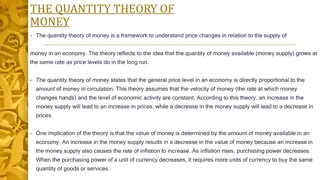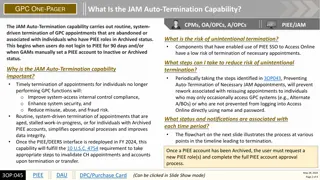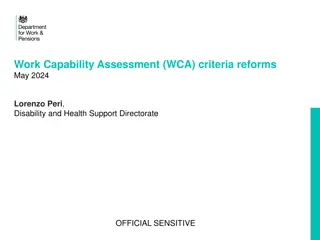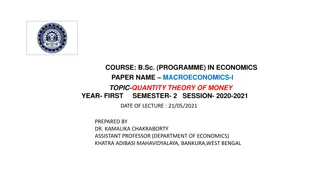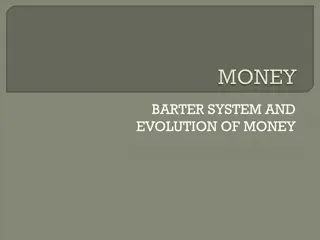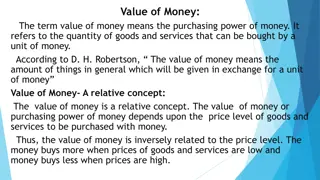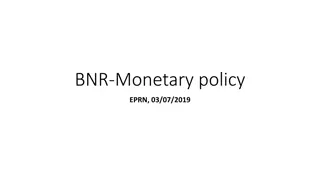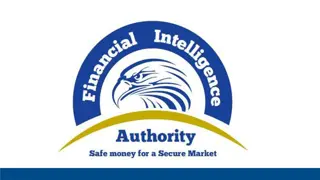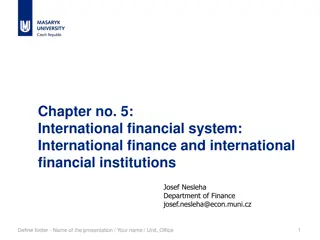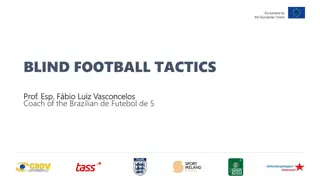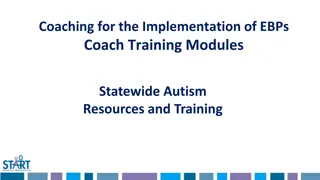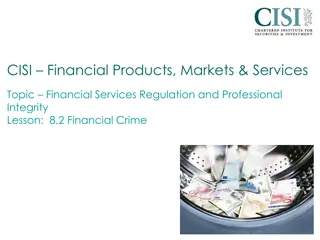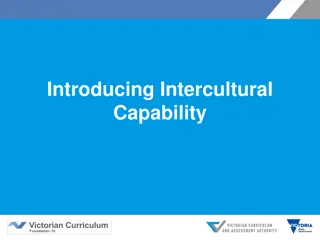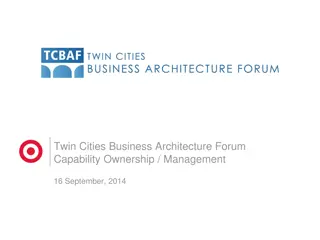Project Money Coach Training 2020: Empowering Financial Capability
Project Money Coach Training 2020 is aimed at empowering individuals to achieve financial goals through a structured 8-week program. Participants are guided by dedicated volunteers to reduce debt, increase credit, and gain a deeper understanding of financial matters. The training emphasizes client-coach relationships, data tracking, and common client issues. The ultimate goal is to transition individuals from financial uncertainty to security. Through interactive sessions and materials like "Your Money, Your Goals" and one-on-one coaching, participants are equipped to create personalized financial plans.
Download Presentation

Please find below an Image/Link to download the presentation.
The content on the website is provided AS IS for your information and personal use only. It may not be sold, licensed, or shared on other websites without obtaining consent from the author.If you encounter any issues during the download, it is possible that the publisher has removed the file from their server.
You are allowed to download the files provided on this website for personal or commercial use, subject to the condition that they are used lawfully. All files are the property of their respective owners.
The content on the website is provided AS IS for your information and personal use only. It may not be sold, licensed, or shared on other websites without obtaining consent from the author.
E N D
Presentation Transcript
WELCOME VOLUNTEERS!
Project Money Coach Training 2020
Introduction: Who We Are Who we are: Carly Oishi Director of Financial Capability Lupe Marin Program Manager coishi@goladderup.org lmarin@goladderup.org Now lets take a few minutes for you to introduce yourselves. Please state your name, how you found out about Project Money and something interesting about you.
Zoom All of you are currently muted in this presentation to ensure a smooth process. Please use the "raise your hand" and Chat function to ask questions. There will also be time at the end to discuss topics in more detail.
History Project Money has helped hundreds of clients by reducing debt, increasing credit, and helping clients understand their financial situation. This, of course, cannot be done without the help of our wonderful volunteers. In the 2019 class we had a total of 52 graduates all of which were able to form some type of financial plan to help them focus on their financial goals.
After today, you will Understand how our program works. Know how to assist you client Understand your role as a coach How to track your client data Have a basic understanding of the issues you may encounter with your clients
The goal of Project Money is to empower people to accomplish specific goals meant to help them move from financial uncertainty to financial security.
Structure of Project Money 8-week program Tuesday or Thursday evening Coaching every other week Class Sections: Tuesday or Thursday Time: 6:00 pm 6:30 pm Presentation for Clients 6:30 pm 7:30 pm One-on-One Coaching Completion Event: TBD
Materials 1. Your Money, Your Goals 2. Client Hand Book 3. Resource Website 4. Jumpcredit
Your Money, Your Goals The Your Money, Your Goals handbook was created by the Consumer Financial Protection Bureau and it is a great tool for coaches to help clients achieve their goals. There are many worksheets that you will be able to access for your client and will be referenced in the modules.
Client Handbook Each client will be receiving a handbook that will follow a structured lesson plan. You are not obligated to stick to this order as not all clients have the same goals. The biggest subjects that are emphasized are debt reduction, credit, and budgeting. Listen to what your client has to say on their first day and you will be able to assess where you should start and focus. We suggest that you look over what information and handouts have access to as it could be helpful for them to progress on their goal.
Resource Page You will all have access to our password protected site at https://www.goladderup.org/project- money/ the password is pm20 This resource page will be your home base for contacting us, gaining knowledge, resource links, and where you will be tracking your client information. Anything you can potentially need access to is in this website.
Financial Coaching Role As a financial coach you will be there to support your client by giving them the tools needed to become financially empowered. Clients will come to you for guidance on how to start a budget, increase their credit, talk about their options in reducing debt, and much more. It is up to you to give them the best advice possible and be able to teach them how to best take care of their financial situation. You will use goal-focused methods to help your client set and achieve them. Our goal is to help the client feel better about their situation and help them take the control of their finances.
Financial Coaching Role The coaching is primarily led by the participant and the coach is there to listen and support them. Coaches can find themselves in situations where they must hold back from giving advice or directing the process. Coaches should try to help find creatives ways to help the individual achieve their own goals. Primary traits needed to be a good coach: The ability to establish and build trust The ability to communicate via active listening and powerful questioning The ability to follow through and monitor progress The ability to encourage and motivate
Financial Coaching vs. Financial Advisor As a financial coach we want to be able to guide our client to the right resources and the right advice. We will cheer them on in their achievements and help them start achieving the goals that they set. We are NOT financial advisors as they are professionals who can guide clients through investments and financial advice as how to make their money grow.
Coaching Skills Acknowledging Acknowledgment addresses what the client had to do to get to where they are. It addressed the participants inner strengths. Articulate Telling the member what you see them doing. It is powerful to simply repeat the participant s words back to them so they can hear themselves. Asking Permission This helps keep us in check with our personal values and making sure we aren t inserting ourselves into their action plan. Bottom-lining We want to be as direct with the client as possible and have the client be as direct with us as we can to be able to guide them better.
Coaching Skills Brainstorming Together with your client you want to be able to work together and think about ideas that they might not have previously thought of. It a creative exercise to help find solutions with your client. Challenging This is done by asking open ended questions and helps the client think in another way. You are challenging the way they would normally view an issue. Championing You are your clients cheerleader and you are there to remind them that they can reach their goals despite their doubts Clearing This is when the client will vent out to you and you have to be as an active listener to see where we can find a root cause of a problem.
Coaching Skills Intruding Sometimes you may need to stop your client in a non-disrupted way to bring something into light. This helps you be honest and forward with them. Reframing This helps the client view something from a different perspective.
Understanding Your Client Listen for the emotions behind financial decisions Peoples finances are very personal and can come with many emotions. Include questions about what money means to them and what the most difficult thing about money is. Understand the value around money Does your client enjoy eating out? Buying gifts? Understanding what goes behind their decisions..
Keeping Our Values In Check Many of you come from different backgrounds and some even financial backgrounds but we want to maintain our personal values of something in check. We never want the client to feel bad about their past decisions or judge them for what they've done in the past. What they value on how they feel about money may not be the same way that you feel or view a issue. They aren t here to hear about how we solved an issue but rather for you to guide them how they can solve their own.
Focusing Develop a partnership with your member. Remember and assure them that they are the experts on their own lives and they know what they could be doing best for themselves. Acknowledge that you don t have all the right answers. Give advice to the client only if they request it and even then reassure them that it is still their choice.
Evoke Change Affirmations are verbal statements that acknowledge what you noticed was positive about your member. We want to Affirm our member by: Focusing on what is positive about your member Recognize specific positive actions your member is taking Use phrases like You got a lot done despite all the setbacks You ve thought this through You tried your best this week
At the end of the day WE ARE HERE TO SUPPORT AND GUIDE OUR CLIENTS TO THE BEST OF OUR ABILITY AND IT IS UP TO THE CLIENT TO FOLLOW THROUGH.
First things first! One of the very first meeting with your client you should get to know each other. Learn about their values and relationship with money as well as what brought them to seek out this class. The biggest thing we want to establish in their first meeting is a goal. Do they want to reduce their debt? Or maybe its starting a savings account to be able to put a down payment on a property? Listen to what your client want to work on and set something down on paper. It is OUR goal to help them figure this out and by the end of this course they should have a set financial plan to continue after they stop seeing us.
Client Data Tracking Please use the Financial Coaching Tracker to track your clients progress. The form will be available in the portal. We will be tracking: Goal settings and achievements Action plans Credit changes Debt changes Savings changes Please make sure to complete these after every session as we want to be able to keep track of client achievements and progress.
Last Meeting - Action Plan We never expect clients to have their financial goals completed at the end of their sessions. However, we do want clients to have the confidence and a plan that will help them stick to and achieve their goals after they stop coming to see us. We have set up a document that you will complete with your clients to ensure that they have written out what their long term is and how they plan to achieve it. We want to make sure the client knows that there is a plan set for them to follow. Please remind your client that if they would like to continue their financial coaching journey they are able to come back to us through individual financial coaching in the office with us.
Pulling A Credit Report Most clients will want their credit report pulled so you will head over to www.annualcreditreport.com to help them pull it. 1. Fill in all information that is requested from the website. 2. It will ask for a current address in which the client has lived for two years or more. 3. If the client hasn t lived in their home for longer than two years provide a previous address. 4. Have your client answer all the security questions. 1. Some questions may be trick questions so help your client answer them to the best of their ability If a client has no line of credit under their names it will be really hard or not possible at all to pull their credit report because they are credit invisible.
Pulling A Credit Report Continued We want to try to pull the TransUnion credit report as it tends to be the most accurate and will allow us to use the Jump Credit software. Jump Credit is a software that is exclusively in use at VITA sites and is used to help the client gain a better understanding of their credit report. It generates an Action Plan for them and goes over what potentially could be harming their credit report.
We are going to go over how you use Jump Credit. Login: COACH_ladderup Password: blueturtle STEP 1: Go to annualcreditreport.com to pull the clients TransUnion credit report. STEP 2: Enter in your clients information STEP 3: Select TransUnion and ONLY TransUnion STEP 4: Answer security questions STEP 5: Save report as a PDF STEP 6: Head to JumpCredit and input clients email address if they have one. STEP 7: Write down the File Passcode for them so they can gain access to their information. STEP 8: Drag and upload the clients Credit Report STEP 9: Click submit.
Jump Credit Continued An Action Plan should have downloaded automatically, which you can open and read with your client. You can practice uploading a credit report by going under the MORE tab and clicking on NEW USERS in which it will guide you in understanding what is on the Action Plan. The Action Plan covers: 3 overall tips that will help the client reduce debt or increase their score An estimate of what your credit score is Account summaries Listed accounts (Open, closed, collections) Listed hard inquiries There are sample credit reports and action plans you can view on Jump Credit so you can become familiar.
CFR Prepaid Debit Cards Clients may not have access or may not trust a traditional bank so they go to Check Cashing stores. Ladder Up offers free prepaid debit cards in which you can open up for your client which are sponsored by US Bank. The card is free of fees and charges as long as the client remains active The client can deposit cash or have direct deposit on the card. They can withdraw money from any US Bank or any authorized ATM. There is more literature on it inside of your manual.
Questions? Concerns? Comments?
WE WILL SEE YOU IN JULY! Thank You For Coming! If you have any other questions please contact us at saveup@goladderup.org


